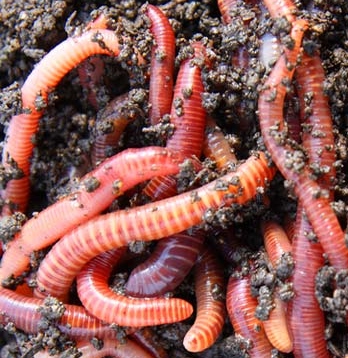Recognizing the Advantages of Red Wiggler Composting: Just How This Reliable Method Changes Organic Waste Into Nutrient-Rich Soil Amendments
Red Wiggler composting, employing the types Eisenia fetida, offers an engaging approach to natural waste monitoring, converting kitchen scraps and lawn particles right into beneficial soil changes. This technique not just improves dirt fertility yet additionally addresses pushing environmental issues, consisting of garbage dump waste decrease and greenhouse gas exhausts.
What Are Red Wigglers?
Red wigglers, medically called Eisenia fetida, are a species of earthworm that play an essential function in vermicomposting systems. These worms are defined by their reddish-brown shade, segmented bodies, and an unique capability to prosper in organic-rich settings, making them ideal for composting applications - Red Wiggler Composting. Unlike their garden-dwelling counterparts, red wigglers prefer to inhabit the upper layers of dirt, where rotting matter is plentiful
Typically gauging between 3 to 4 inches in length, red wigglers have a high reproductive price, enabling them to increase rapidly under optimum conditions. They have a distinct gastrointestinal system that enables them to process natural waste successfully, converting it right into nutrient-rich castings, which are highly helpful for plant growth.
Their resistance to varying wetness degrees and temperature ranges even more enhances their energy in vermicomposting arrangements, making them a favored selection among composting fanatics. Additionally, red wigglers are aerobic microorganisms, which necessitates a well-aerated composting environment, making certain efficient decomposition. Recognizing the biological traits and habits of red wigglers is essential for enhancing their usage in sustainable waste administration practices.

Advantages of Vermicomposting
Harnessing the power of vermicomposting deals a multitude of ecological and agricultural advantages. It substantially lowers organic waste in garbage dumps, thus minimizing methane discharges, a powerful greenhouse gas. By drawing away food scraps and backyard waste to vermicomposting, we support a more sustainable waste administration system.
In addition, vermicomposting improves soil wellness. The castings created by red wigglers are abundant in essential nutrients, microbes, and enzymes, enhancing dirt framework and fertility. This nutrient-rich amendment promotes robust plant growth and boosts water retention, reducing the need for chemical fertilizers.
Furthermore, vermicomposting fosters biodiversity in the soil community. The introduction of useful microbes from worm spreadings help in condition reductions and nutrient biking, producing a much healthier atmosphere for plants.
Financially, vermicomposting lowers the prices connected with chemical inputs and garbage disposal. Farmers and garden enthusiasts can grow top quality fruit and vegetables at reduced expenses, adding to food safety and sustainability.
Exactly How to Begin Composting
Beginning a composting endeavor can be a simple and gratifying process. To start, pick an ideal area that is well-drained and gets partial sunlight. This will aid preserve a balanced temperature level, crucial for the composting process. Next off, select a compost container or develop an assigned area in your yard, ensuring it is easily accessible for gathering and adding products compost.
Collect natural materials such as kitchen scraps, lawn waste, and shredded paper. Aim for a well balanced mix of 'eco-friendly' products, high in nitrogen (e.g., fruit scraps, coffee grounds), and 'brownish' materials, abundant in carbon (e.g., dried fallen leaves, cardboard) A ratio of about 2:1 green to brown products is perfect.
Beginning layering your materials, making certain sufficient air blood circulation by turning the stack consistently. This promotes cardio decomposition, minimizing odors and speeding up the process. Display moisture levels; the garden compost should seem like a moist sponge but not extremely wet.
Nutrient Profile of Vermicompost
Composting, particularly with red wigglers, yields a nutrient-rich product recognized as vermicompost. Additionally, it provides micronutrients go right here like magnesium, iron, and calcium, promoting robust plant development and enhancing dirt health and wellness.
The microbial task existing in vermicompost better improves its account, introducing advantageous microorganisms and fungis that advertise nutrition availability and uptake in plants. This biological part help in reducing plant diseases and improving dirt framework, causing improved water retention and aeration.

Environmental Effect of Composting
The environmental effect of composting, specifically with using red wigglers, is profound and go right here complex. This approach considerably lowers the volume of natural waste sent out to landfills, which consequently lessens greenhouse gas emissions, specifically methane-- a potent contributor to environment adjustment. By diverting organic products from land fills, red wiggler composting not just helps alleviate ecological degradation however additionally promotes sustainable waste administration practices.

Moreover, composting adds to carbon sequestration, as the procedure records co2 from the ambience and shops it in the soil. This natural process aids in combating climate modification while enriching the dirt - Red Wiggler Composting. On the whole, red wiggler composting provides a sensible, green service for waste management and environmental sustainability, advertising much healthier ecological communities and an extra sustainable future
Final Thought
Finally, Red Wiggler composting functions as an effective approach for converting organic waste into beneficial dirt changes. The process not only enhances dirt fertility and structure but additionally minimizes ecological issues related to garbage disposal. By using Eisenia fetida, this form of vermicomposting adds to enhanced biodiversity and supports lasting agricultural practices. Inevitably, Red Wiggler composting plays a vital duty in advertising healthier ecological communities and attending to the challenges of environment modification.
Red Wiggler composting, employing the types Eisenia fetida, offers a compelling strategy to natural waste management, transforming kitchen scraps and lawn particles into useful soil changes. Unlike their garden-dwelling equivalents, red wigglers prefer to inhabit the top layers of dirt, where decomposing matter is bountiful.
The castings created by red wigglers are abundant in important nutrients, germs, and enzymes, enhancing dirt structure and fertility. The nutrient-rich by-products of red wiggler task boost soil structure, boost water retention, and advertise biodiversity within the soil environment.In conclusion, Red Wiggler composting serves as an efficient approach for converting organic waste into useful dirt amendments.